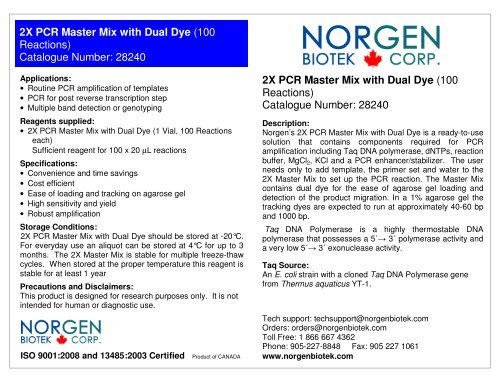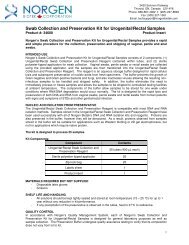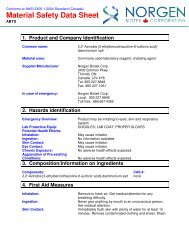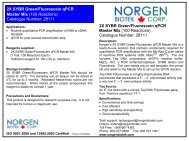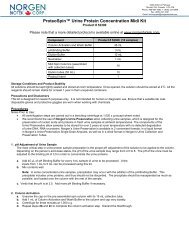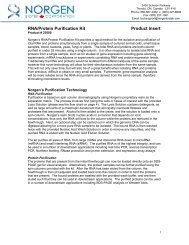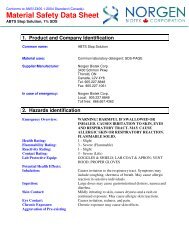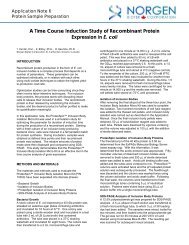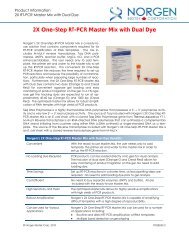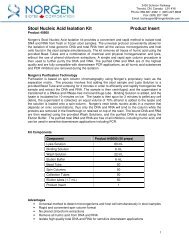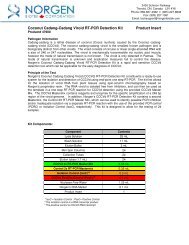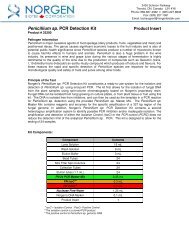2X PCR Master Mix with Dual Dye (100 Reactions ... - Norgen Biotek
2X PCR Master Mix with Dual Dye (100 Reactions ... - Norgen Biotek
2X PCR Master Mix with Dual Dye (100 Reactions ... - Norgen Biotek
You also want an ePaper? Increase the reach of your titles
YUMPU automatically turns print PDFs into web optimized ePapers that Google loves.
<strong>2X</strong> <strong>PCR</strong> <strong>Master</strong> <strong>Mix</strong> <strong>with</strong> <strong>Dual</strong> <strong>Dye</strong> (<strong>100</strong><br />
<strong>Reactions</strong>)<br />
Catalogue Number: 28240<br />
Applications:<br />
• Routine <strong>PCR</strong> amplification of templates<br />
• <strong>PCR</strong> for post reverse transcription step<br />
• Multiple band detection or genotyping<br />
Reagents supplied:<br />
• <strong>2X</strong> <strong>PCR</strong> <strong>Master</strong> <strong>Mix</strong> <strong>with</strong> <strong>Dual</strong> <strong>Dye</strong> (1 Vial, <strong>100</strong> <strong>Reactions</strong><br />
each)<br />
Sufficient reagent for <strong>100</strong> x 20 µL reactions<br />
Specifications:<br />
• Convenience and time savings<br />
• Cost efficient<br />
• Ease of loading and tracking on agarose gel<br />
• High sensitivity and yield<br />
• Robust amplification<br />
Storage Conditions:<br />
<strong>2X</strong> <strong>PCR</strong> <strong>Master</strong> <strong>Mix</strong> <strong>with</strong> <strong>Dual</strong> <strong>Dye</strong> should be stored at -20°C.<br />
For everyday use an aliquot can be stored at 4°C for up to 3<br />
months. The <strong>2X</strong> <strong>Master</strong> <strong>Mix</strong> is stable for multiple freeze-thaw<br />
cycles. When stored at the proper temperature this reagent is<br />
stable for at least 1 year<br />
Precautions and Disclaimers:<br />
This product is designed for research purposes only. It is not<br />
intended for human or diagnostic use.<br />
ISO 9001:2008 and 13485:2003 Certified Product of CANADA<br />
<strong>2X</strong> <strong>PCR</strong> <strong>Master</strong> <strong>Mix</strong> <strong>with</strong> <strong>Dual</strong> <strong>Dye</strong> (<strong>100</strong><br />
<strong>Reactions</strong>)<br />
Catalogue Number: 28240<br />
Description:<br />
<strong>Norgen</strong>’s <strong>2X</strong> <strong>PCR</strong> <strong>Master</strong> <strong>Mix</strong> <strong>with</strong> <strong>Dual</strong> <strong>Dye</strong> is a ready-to-use<br />
solution that contains components required for <strong>PCR</strong><br />
amplification including Taq DNA polymerase, dNTPs, reaction<br />
buffer, MgCl2, KCl and a <strong>PCR</strong> enhancer/stabilizer. The user<br />
needs only to add template, the primer set and water to the<br />
<strong>2X</strong> <strong>Master</strong> <strong>Mix</strong> to set up the <strong>PCR</strong> reaction. The <strong>Master</strong> <strong>Mix</strong><br />
contains dual dye for the ease of agarose gel loading and<br />
detection of the product migration. In a 1% agarose gel the<br />
tracking dyes are expected to run at approximately 40-60 bp<br />
and <strong>100</strong>0 bp.<br />
Taq DNA Polymerase is a highly thermostable DNA<br />
polymerase that possesses a 5´→ 3´ polymerase activity and<br />
a very low 5´→ 3´ exonuclease activity.<br />
Taq Source:<br />
An E. coli strain <strong>with</strong> a cloned Taq DNA Polymerase gene<br />
from Thermus aquaticus YT-1.<br />
Tech support: techsupport@norgenbiotek.com<br />
Orders: orders@norgenbiotek.com<br />
Toll Free: 1 866 667 4362<br />
Phone: 905-227-8848 Fax: 905 227 1061<br />
www.norgenbiotek.com
Tips for Performing <strong>PCR</strong> <strong>Reactions</strong>:<br />
The Polymerase Chain Reaction (<strong>PCR</strong>) is a powerful method<br />
used to amplify specific DNA sequences using multiple cycles<br />
of a 3-step process: denaturation, annealing, extension.<br />
Successful <strong>PCR</strong> relies on various factors, and it is important<br />
to keep a number of points in mind when performing <strong>PCR</strong>:<br />
1. Using high quality, purified DNA templates greatly<br />
enhances the success of <strong>PCR</strong><br />
2. Clean, disposable gloves should be worn at all times when<br />
handling reagents, samples, pipettes, disposable tubes, etc.<br />
It is recommended that gloves are changed frequently to<br />
avoid contamination.<br />
3. There should be designated solutions, tips, tubes,<br />
pipettes, etc. for <strong>PCR</strong> only.<br />
4. Optimize the template amount: up to 1 µg genomic DNA<br />
and <strong>100</strong> ng-10 pg for cDNA or plasmid.<br />
Procedure<br />
Reaction Setup Table<br />
<strong>PCR</strong> Reaction <strong>Mix</strong>ture 20 µL Rxn 50 µL Rxn<br />
<strong>2X</strong> <strong>PCR</strong> <strong>Master</strong> <strong>Mix</strong> 10 µL 25 µL<br />
Template DNA 1 - 2 µL 1 - 2 µL<br />
Primer F (2.5 µM) 1 µL 1 µL<br />
Primer R (2.5 µM) 1 µL 1 µL<br />
Nuclease-free water Up to 20 µL Up to 50 µL<br />
1. Dispense either 10 µL or 25 µL of <strong>2X</strong> <strong>PCR</strong> <strong>Master</strong> <strong>Mix</strong> into<br />
the <strong>PCR</strong> tube according to the desired final volume of the<br />
<strong>PCR</strong> reaction (see Reaction Setup Table above).<br />
2. Add template DNA (10 pg – 1 ng for plasmid and 0.1 –<br />
1 µg for genomic DNA ) and both forward and reverse<br />
primers (2.5 µM of each) to the <strong>PCR</strong> tube as shown in the<br />
Reaction Setup Table.<br />
3. Add nuclease-free water to bring the total volume to either<br />
20 µL or 50 µL.<br />
4. <strong>Mix</strong> the <strong>PCR</strong> mixture thoroughly and spin down briefly.<br />
5. Add a drop of mineral oil if the thermocycler is not<br />
equipped <strong>with</strong> a heated lid.<br />
6. Place the <strong>PCR</strong> tubes into the thermocycler and carry out<br />
the <strong>PCR</strong> according to the Suggested <strong>PCR</strong> Cycle Conditions<br />
shown in the table below.<br />
Suggested <strong>PCR</strong> Cycle Conditions<br />
<strong>PCR</strong> Cycle Step Temperature Time<br />
No. of<br />
cycles<br />
Initial Denaturation 94 - 95°C 2 min 1<br />
Denaturation 94 - 95°C<br />
Annealing 50 - 65°C<br />
Extension 65 - 72°C<br />
15 – 30<br />
sec<br />
15 – 30<br />
sec<br />
1 minute<br />
per kb<br />
30 - 40<br />
Final Extension 72°C 5 min 1<br />
Hold 4 - 10°C Indefinitely 1<br />
7. After completion of <strong>PCR</strong>, a10 µL aliquot of the reaction<br />
can be mixed <strong>with</strong> 2 µL of loading dye (6X) and loaded onto<br />
an agarose gel for visual analysis.<br />
V 1.0


